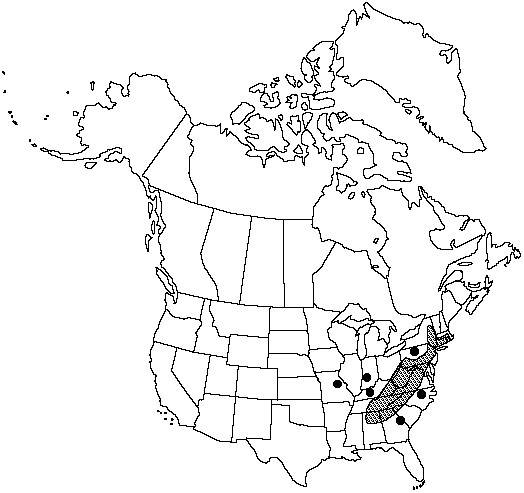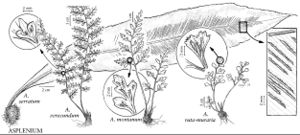Asplenium montanum
Sp. Pl. 5(1): 342. 1810.
Roots proliferous. Stems horizontal, often arching upward, unbranched (although clusters of stems often form from root proliferations, giving false appearance of single much-branched stem); scales dark brown throughout, narrowly deltate, 2–4 × 0.2–0.4 mm, margins entire. Leaves monomorphic. Petiole dark brown to purplish black, lustrous proximally, fading to green distally, 2–11 cm, 1/2–1 1/2 length of blade; indument of blackish, narrowly lanceolate scales only at very base and of minute hairs. Blade deltate to lanceolate, 1–2-pinnate-pinnatifid, 2–11 × 1–7(–10) cm, thick, essentially glabrous; base truncate or obtuse; apex acuminate to acute, not rooting. Rachis green throughout, dull, sparsely pubescent. Pinnae in 4–10 pairs, deltate to lanceolate; proximal (longest) pinnae 6–35 × 4–20 mm; base obtuse to acute; margins coarsely incised; apex acute to rounded. Veins free, obscure. Sori 1–15 per pinna, on both basiscopic and acroscopic sides. Spores 64 per sporangium. 2n = 72.
Habitat: Crevices in sandstone or other acidic rocks
Elevation: 0–2000 m
Distribution

Ala., Conn., Ga., Ind., Ky., Md., Mass., Mo., N.J., N.Y., N.C., Ohio, Pa., R.I., S.C., Tenn., Va., W.Va.
Discussion
Asplenium montanum occurs principally in the Appalachian region, with outlying localities in the Shawnee Hills of western Kentucky (R. Cranfill 1980) and adjacent Indiana (D. M. Smith 1956). A report of its disjunct occurrence on the northern edge of the Ozarks is based on a single specimen whose label indicates the collection locality near Graham Cave, Montgomery County, Missouri. Efforts by several botanists to relocate the population have failed. Reports of a disjunct station in the upper peninsula of Michigan are doubtful.
Asplenium montanum is an ecological specialist. It is typically the sole vascular plant species in the siliceous rock crevices in which it is found. It may occur, however, with two allotetraploid species, A. bradleyi and A. pinnatifidum, which were derived from hybrids of A. montanum with A. platyneuron and A. rhizophyllum, respectively. In addition, A. montanum crosses frequently with A. pinnatifidum producing A. × trudellii and rarely with allotetraploid individuals of A. bradleyi producing A. × wherryi.
Selected References
None.
